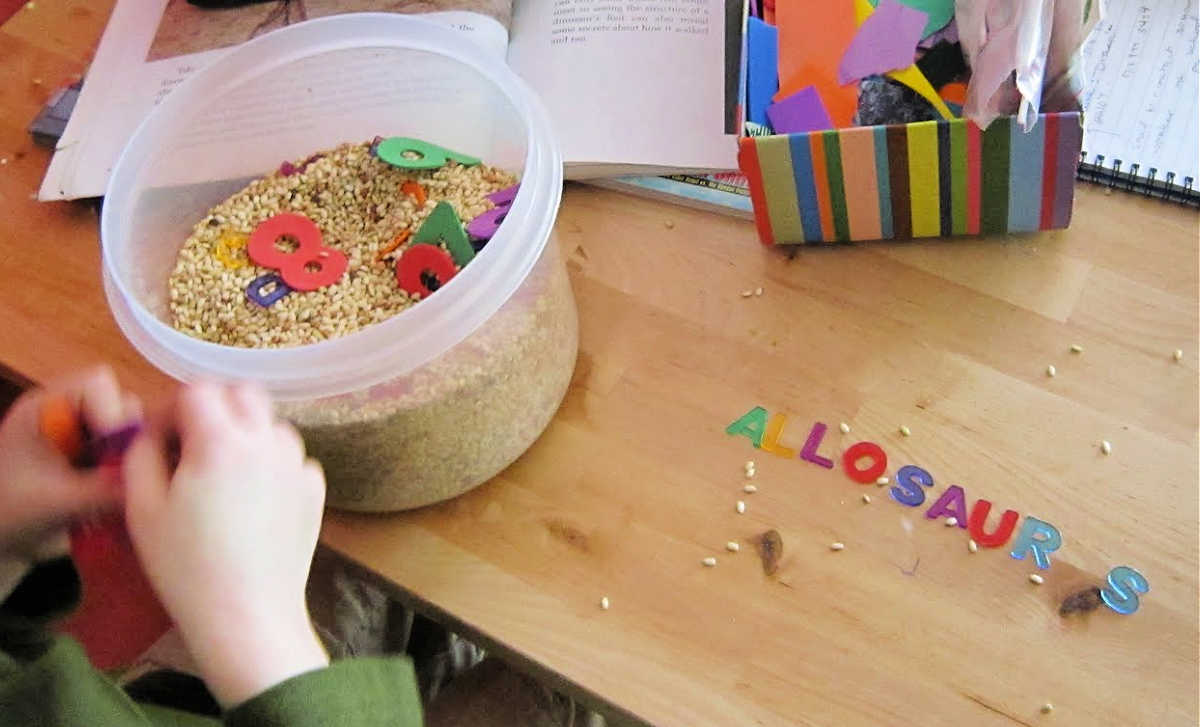An alphabet sensory bin combines a tactile experience with a literacy activity, allowing children to learn through play. As we all know, children learn best through play!
Hunting for letters in a sensory material, especially when reinforced by reading a lot of great alphabet picture books is an excellent, hands-on way to help your kids learn their ABCs (letter recognition).
Not only that, a sensory bin acts as a great boredom buster at home when you are having trouble finding ways to keep your preschooler or kindergartener occupied!

Note: this post contains affiliate links. Qualifying purchases may earn commission.
How to Make an Alphabet Sensory Bin
We reused our materials from the Sift 'n' Spell spelling game to easily put together an activity that makes learning the alphabet fun.
Materials
Sensory material. Use rice, dried barley, macaroni pasta shapes, dried beans or lentils.
Container. This should be large enough to hold a multitude of letters.
Letters. What can you use for letters? If you have an alphabet puzzle, repurpose the pieces, otherwise, you can write the letters on small pieces of cardboard (a cereal box is perfect for this), or index cards (cut them in quarters).
We used small plastic letters like these and foam letters, but it's definitely not necessary to purchase any special materials.
MORE: Fun ABC activities for kids
Instructions
Fill the container with the sensory material. Aim for half to two-thirds full.
Add the letters into the sensory bin and mix everything up.
Show your child how to use their hands to sift through the sensory material to find the letters.
Teacher or Parent Input
While it's perfectly fine to allow your child to engage in supervised play using the letter sensory bin without your input, this is a good opportunity make observations that reinforce the concepts your child is learning.
Comments you can make include the following:
You found a letter! What letter is that?
What sound does that letter make?
Can you think of a word that starts with that sound or letter?
Which are the uppercase and which are the lowercase letters?
I see a "C"! Can you find it?
For children who are starting to spell or read:
I see you found a lot of letters! Do any of them make a word?
Do you see the "C" and the "A" and the "T"? What word does that make?
Can you match the lowercase "a" to the uppercase "A"?
What age is the alphabet sensory bin for?
Sensory bins with small objects like plastic letters are for ages 3 and up (children must have stopped putting items in their mouths).
It's easy to level up the bin for children starting to work on phonics, reading and spelling skills. Just make sure you include enough letters for word formation.
Even if your young children get carried away, don't avoid this activity because you are afraid of a mess!
9 More Alphabet Sensory Bin Ideas
It's easy to add variety to your sensory bins so that each time your child includes it in their learning play, it's a unique experience. Try one of the following ideas:
- Add numbers to the bin.
- Use both lowercase and uppercase letters.
- Add in surprises like small toy figurines.
- Use a large baking dish, and include a toy digger to dig for the letters. See how we made a digger bean tray here.
- Instead of a dried sensory material, use shaving cream or a bubble bath.
- Freeze letters in ice, like we did in our frozen word scramble.
- Use alphabet pieces from a wooden alphabet peg puzzle. After retrieving each piece, place in the correct spot on the puzzle. Your child will know he's found all the letters when the puzzle is complete!
- If you're not afraid of mess, try a Jell-O letter hunt!
- If your sensory material is fine enough, use a berry basket to sift through the material to find the letters. See how this works with sand as the sensory material.
MORE: Picture Books that Instill of Love of Word Play
First published 2010, updated 2023.




Anna - Three Sneaky Bugs says
Fun and simple. Just the way I like it!
Raising a Happy Child says
Wow, this is pretty neat. I have a hunch that our letters would end up as cookies or whatever they usually end up to be, but it certainly looks like fun. What kind of alphabet is it - the letters look very pretty.
amandab says
I'm pretty impressed with his word also! 🙂
joyce:waddleeahchaa.com says
I love when learning is fun! 🙂